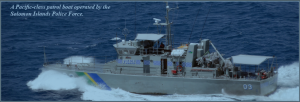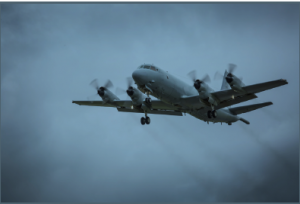- Author
- A.N. Other
- Subjects
- None noted
- Tags
-
- RAN Ships
- None noted.
- Publication
- June 2018 edition of the Naval Historical Review (all rights reserved)
The following article first appeared in the Air Power Development Centre Bulletin Pathfinder Issue 281 dated February 2017 and is reproduced with their kind permission. The perspective of a sister service on maritime operations is greatly appreciated.
Fisheries sustain many households in the Pacific Island Countries and supply the majority of livelihoods and food security. Australian Centre forInternationalAgriculture Research
One of the Strategic Defence Interests identified in the 2016 Defence White Paper ‘is in a secure nearer region, encompassing maritime South East Asia and the South Pacific’. To further this interest, the Government requires Defence to ‘support the security of maritime South East Asia and support the governments of Papua New Guinea, Timor-Leste and Pacific island countries to build and strengthen their security’. The White Paper reaffirms Australia’s posture to continue to seek to be the principal security partner forPapuaNew Guinea,Timor-Leste and Pacific island countries in the South West Pacific.
Although cast in new language, Defence has played an enduring role in contributing to the security of the Pacific island countries. Oneof the mostvisible missions by which the Australian Defence Force (ADF) has done this is through the conduct of fisheries patrols as part of Operation Solania by the employment of airborne intelligence surveillance and reconnaissance (ISR) capabilities.
Operation Solania is the ADF’s contribution to a multinational operation led by the Pacific island-based ForumFisheriesAgency(FFA).These operations, which occur four times a year, are conducted to monitor fishing activity across the South West Pacific, in particular seeking to detect, localise and intercept illegal fishing activity within the Exclusive Economic Zones (EEZ) of the Pacific island countries.
The size of the EEZs relative to the Pacific islands countries means that the task of countering illegal fishing in the region is beyond the capabilities of the countries themselves. Accordingly, the four dedicated operations conducted by the FFA each year are supported by contributions from Australia, NewZealand, the United States of America and France (a collection of states referred to as the Quadrilateral Nations or QUADS).Each member of the QUADS provides support to the FFA-led operations in the form of air or naval assets, which significantly increase the FFA’s ability to effectively patrol and enforce the economic rights that are critical to the security and economic livelihood of the Pacific island countries.

The first of these operations for 2016 was Operation Rai Balang 12016 which was conducted in April 2016. In addition to the participation from the QUADS, participants were provided from the Federal State of Micronesia, Nauru, Palau, Papua New Guinea,Republic of the Marshall Islands, Solomon Islands and Vanuatu. The operation included seven Pacific-class patrol boats from participating island nations, a United States Coast Guardc utter, a French patrol boat and five maritime patrol aircraft provided by QUADs nations: aRAAFAP-3C, aRNZAFP-3K2, aFrenchF200 Guardian, aUS Coast Guard HC-130 and a USNP-8. The ADF contribution was one RAAFAP-3 Candan air liaison officer to support the FFA Regional Fisheries Surveillance Centre in Honiara. The QUADS aircraft were deployed and operated from different locations across theSouthWest Pacific to provide extended reach, improved coverage oft he area and dedicated support to the patrol boats of participating countries.

A total of 26 sorties was flown by the five participating aircraft, providing a total of 135 on-station hours and patrolling nearly 2 million nautical square miles of ocean. With the potential illegal fishing contacts reported directly to the control centres, the aircraft involved in the operation enabled the supported maritime forces to conduct 60 high sea vessel boardings, leading to two infringements and three arrests. Although these numbers appear small, they send a strong message to illegal fishers and represent an invaluable contribution to ensuring the economic security of the regional states through both apprehending those detected engaging illegal fishing, as well as deterring future activity.
In addition to countering potential illegal fishing activity, the operation provided opportunities and benefits by enhancing Pacific island country involvement, participation and capacity in maritime fisheries surveillance and response operations and intelligence exchanges. This allows future operations to be more responsive to intelligence cueing. Like all deployed, low-footprint tropical operations, weather played a significant part, and technical support is always a limiting factor.
Post-mission intelligence analysis of the operation showed validation of the intelligence, andf isheries tracking and monitoring systems of the FFA, with many useful lessons identified. The deployed Air ForceAP-3C Orion provided a large volume of mission imagery through the simple exchange of an unclassified DVD. The operation successfully practised exchanging regional coordination information of fishing activities and demonstrated Australia’s commitment to conduct regional maritime surveillance enabling regional nations to practisel ocal maritime security operations.
Due to the enormous size of the area, air power plays a critical role in Operation Solania. TheAP-3C will continue to contribute tot his operation until its planned withdrawal from service at the end of 2018. However,over the coming years, the ADF will introduce new capabilities that will continue to improve Australia’s ability to contribute to regional maritime surveillance. Int he coming years, the P-8A Poseidon will replace theAP-3C. TheP-8A will provide increased availability, faster response and updated sensors, weapons and communications. In the next decade, the introduction of the MQ-4A Triton will further enhance Australia’s ability to patrol its maritime area of interest, by providing unrivalled endurance, area coverage and all weather sensors including the multifunction active sensor radar for detecting and identifying targets at sea.
The challenge for Air Force will be to integrate these new capabilities with regional operations, both technically and conceptually, providing optimal outcomes across a diverse range of partners and capabilities. There will be significant challenges in enabling the integrated and networked sharing of data characterised by the volume, and variety of data format.
The security and stability of the South West Pacific is well served by Australian contribution of airborne ISR capabilities, crews and support personnel to the fisheries surveillance role. Operation Rai Balang 2016 has helped to demonstrate that Operation Solania is integral to Defence meeting the Pacific security objectives outlined in the White Paper now and into thef uture.
Key Points
- The security of the Pacific island countries depends on the effective control of the resources in their respective EEZs.
- Through Operation Solania,Australia directly contributes to the economic livelihood of the Pacific island countries.
- The introduction of the P-8APoseidon, soon to be followed by the MQ-4ATriton, will greatly improve Australia’s regional maritime surveillance
1 The name of the operation is a term for Yapese (Micronesian) stone money.




